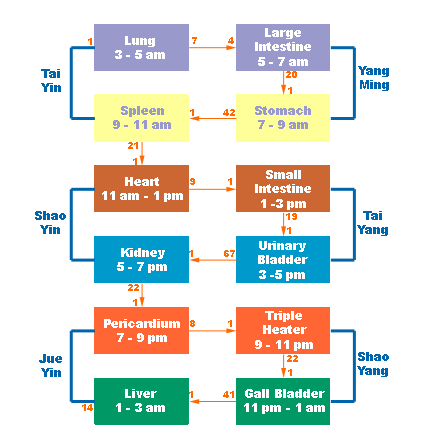Deep Yin Level
Heart (HT), Kidney (KI)
Qi or Yang Deficiency, or Yin Deficiency with Empty Heat
Cold Transformation (Yang Deficiency)
Aversion to cold, cold limbs, lethargy
Diarrhea, absence of thirst
Pale tongue, faint pulse
Heat Transformation (Yin Deficiency)
Irritability, insomnia, dry mouth
Red tongue with little coat, thin rapid pulse
Treatment Principles
Rescue Yang
Nourish Yin, clear Deficiency Heat
Shao Yin (少阴)


Final Stage, Terminal Yin
Liver (LR), Pericardium (PC)
omplex alternation of Heat and Cold, collapse of Yin and Yang
Symptoms
-
Alternating hot and cold sensation
-
Thirst, hunger without desire to eat
-
Diarrhea, possible vomiting of roundworms
-
Cold limbs, faint pulse
Treatment Principle
-
Restore balance between Yin and Yang, clear Heat, warm Interior
-
Complex syndrome, often requires combined approach
Points
LR3, PC6, Ren12, ST36, SP4, DU20
Jue Yin (厥阴)
Half-Interior, Half-Exterior
Gallbladder (GB), Triple Burner (TB)
Alternating pattern, the pivot between Exterior and Interior
Symptoms
-
Alternating chills and fever
-
Bitter taste, dry throat, dizziness
-
Fullness in chest/hypochondrium
-
Nausea, poor appetite
-
Wiry pulse
Treatment Principle
Harmonize Shao Yang, do not sweat or purge
Points
TB5, GB41, GB34, LR14, DU13
Shao Yang (少阳)


Interior, Cold Deficiency Stage
Spleen (SP), Lung (LU)
Yang Deficiency of Spleen, leading to Cold Damp retention
Symptoms
-
Abdominal fullness and pain, relieved by warmth/pressure
-
Diarrhea, poor appetite
-
Absence of thirst
-
Fatigue, cold limbs
-
Pale tongue with white coat
-
Deep, slow pulse
Treatment Principle
Warm the Middle Jiao, tonify Spleen Yang, resolve Damp
Points
Ren12, ST36, SP3, Ren6, BL20
Tai Yin (太阴)
Exterior Layer
Bladder (BL), Small Intestine (SI)
Superficial, first stage of invasion
Symptoms
-
Fever with chills (chills > fever)
-
Aversion to cold or wind
-
Stiff neck, occipital headache
-
Floating pulse
-
Thin white tongue coating
Treatment Principle
Release the Exterior, expel Wind or Cold, harmonize Wei & Ying
Points
BL12, DU16, GB20, LU7, LI4
Tai Yang
(太阳)


Interior, Full Heat Stage
Stomach (ST), Large Intestine (LI)
Excess Heat in Qi level, strong pathogen + strong Zheng Qi
Symptoms
-
High fever, profuse sweating
-
Thirst with desire for cold drinks
-
Red face, irritability
-
Big, surging pulse
-
Red tongue with dry yellow coat
Treatment Principle
Clear Internal Heat, purge Yang Ming Fu organs (esp. ST & LI)
Points
LI11, ST44, ST25, ST37, DU14
Yang Ming (阳明)

The 6 Levels

The 6 Levels
The Six Levels (六经辨证 Liù Jīng Biàn Zhèng) theory is a classical diagnostic model used in Traditional Chinese Medicine (TCM) to understand the progression of externally contracted febrile diseases, especially those caused by Cold pathogenic factors. It originates from the ancient medical classic Shāng Hán Lùn (伤寒论), “Treatise on Cold Damage,” by Zhang Zhongjing (circa 3rd century AD). This theory explains how Cold pathogens penetrate deeper into the body, moving through six energetic layers corresponding to meridians and organ systems. The levels are arranged from exterior (superficial) to interior (deep):
-
Tai Yang (Greater Yang 太阳)
-
Yang Ming (Bright Yang 阳明)
-
Shao Yang (Lesser Yang 少阳)
-
Tai Yin (Greater Yin 太阴)
-
Shao Yin (Lesser Yin 少阴)
-
Jue Yin (Terminal Yin 厥阴)
The Six Levels help track disease progression from superficial to deep. They guide you to decide when to sweat (Tai Yang), purge (Yang Ming), harmonize (Shao Yang), warm (Tai Yin, Shao Yin Cold), nourish Yin (Shao Yin Heat) and stabilize and integrate Yin/Yang (Jue Yin).
